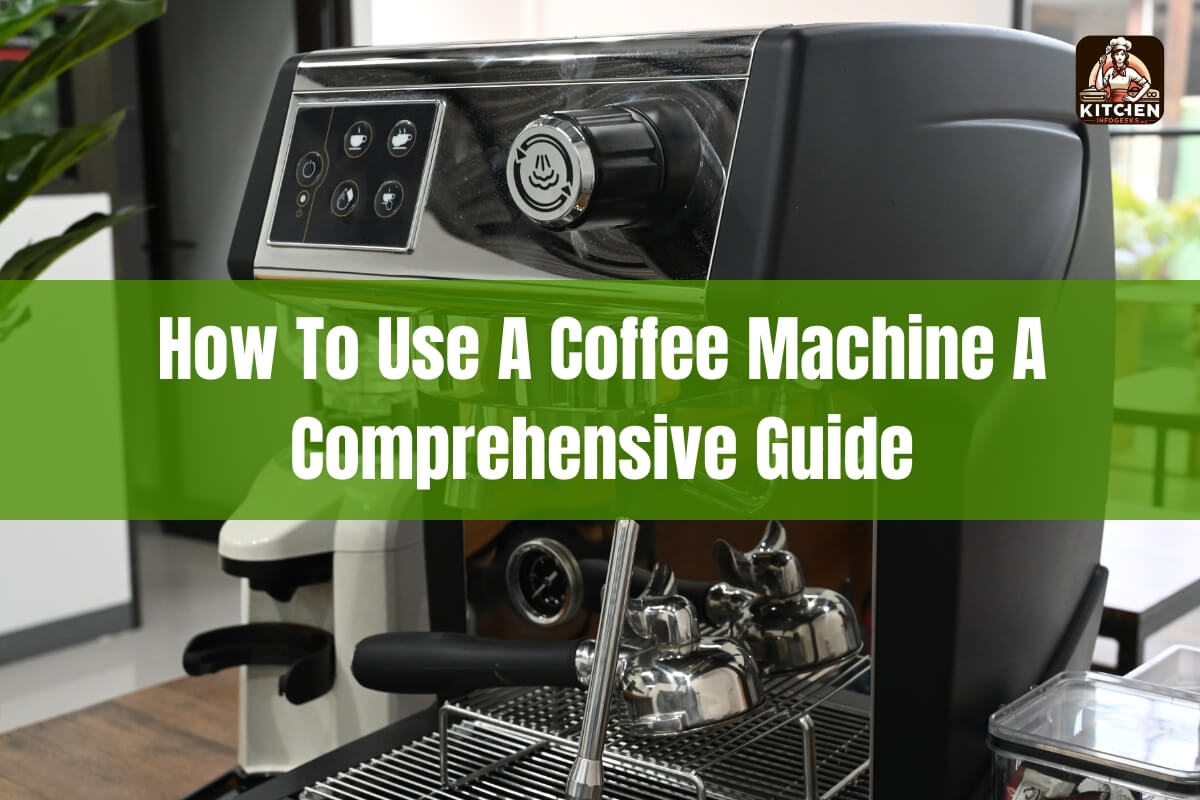
Are you struggling to brew the perfect cup of coffee at home? Don’t worry, you’re not alone. Using a coffee machine can seem daunting, especially if you’re new to it. But fear not, this comprehensive guide will walk you through how to use a coffee machine step-by-step, ensuring you get a delicious, aromatic cup every time.
In this article, we’ll cover everything you need to know, from setting up your machine and choosing the right coffee beans to troubleshooting common issues. We’ll also explore alternative brewing methods and coffee machine features, so you can find the perfect setup for your taste preferences. Let’s dive in!
Setting Up Your Coffee Machine
Before you can start brewing, you need to properly set up your coffee machine. This process typically involves:
- Unboxing and Initial Setup: Follow the manufacturer’s instructions for unpacking and assembling your machine. Ensure all parts are accounted for and positioned correctly.
- Filling the Water Reservoir: Most coffee machines have a removable water reservoir. Fill it with fresh, filtered water for the best-tasting coffee.
- Installing Filters: Depending on your machine, you’ll need to use either paper filters or a reusable mesh filter. Place the filter in the designated basket or compartment.
Choosing the Right Coffee Beans and Grind Size
The quality of your coffee beans and the grind size can significantly impact the flavor of your brew. Here are some tips:
- Fresh, High-Quality Coffee Beans: For the best taste, use freshly roasted, whole bean coffee. Opt for specialty coffee from reputable roasters.
- Roast Levels: Coffee beans can range from light to dark roasts. Experiment to find your preferred flavor profile.
- Grind Size: For drip coffee machines, a medium grind size (similar to coarse sand) is ideal. If you grind the beans too fine, the water will struggle to flow through, resulting in an over-extracted, bitter brew.
Step-by-Step Guide to Making Coffee in a Drip Machine
Now that you’ve set up your machine and gathered your coffee beans, it’s time to brew! Follow these steps for a perfect cup:
- Measure the Coffee-to-Water Ratio: A general guideline is to use about 2 tablespoons (10 grams) of ground coffee per 6 ounces (180 ml) of water. Adjust the ratio to your taste preferences.
- Add Ground Coffee to the Filter: Place the measured grounds in the filter basket, ensuring they’re evenly distributed.
- Set Brew Strength (if applicable): Some machines allow you to adjust the brew strength. Start with the standard setting and adjust as needed.
- Start the Brewing Cycle: Once you’ve added the water and coffee, simply press the brew button or switch to start the brewing process.
Tips for Optimal Brewing Temperature and Time
For the best flavor extraction, the water temperature should be between 195°F and 205°F (91°C and 96°C). Most coffee machines are designed to heat the water to this optimal range automatically.
As for brewing time, it typically takes 3 to 5 minutes for a full pot to brew. Avoid interrupting the brewing cycle, as this can affect the coffee’s flavor and strength.
Cleaning and Maintaining Your Coffee Machine
Regular cleaning and maintenance are essential for keeping your coffee machine in top condition and ensuring consistent, great-tasting coffee. Here’s what you should do:
- Descaling: Over time, mineral deposits from water can build up inside the machine, affecting its performance and flavor. Follow the manufacturer’s instructions for descaling (typically using a vinegar or descaling solution) every few months.
- Cleaning the Carafe and Removable Parts: Disassemble and wash the carafe, filter basket, and other removable parts with warm, soapy water after each use.
- Wiping Down Exterior: Use a damp cloth to wipe down the exterior of the machine, keeping it free from coffee stains and spills.
Troubleshooting Common Coffee Machine Issues
Even with proper care, you may encounter some issues with your coffee machine. Here are some common problems and their solutions:
- Not Brewing/Water Not Flowing: This could be due to a clogged water line or a faulty pump. Try descaling the machine or consulting the manufacturer’s troubleshooting guide.
- Coffee Tastes Bitter or Sour: This can result from using stale or over-roasted beans, an incorrect grind size, or improper water temperature. Experiment with different beans and grind settings, and ensure the machine is properly cleaned.
- Machine Isn’t Heating Up: If the machine isn’t heating the water, there may be an issue with the heating element. Check for any error messages or consult the manufacturer for repair options.
- Leaks or Overflowing: Check that all parts are properly assembled and that the carafe or water reservoir isn’t overfilled. If the issue persists, you may need to replace faulty seals or gaskets.
When to Consider Replacing Your Coffee Machine
With proper care and maintenance, most coffee machines can last several years. However, if you’ve had your machine for a while and it’s consistently underperforming or experiencing frequent issues, it may be time to invest in a new one.
Alternative Brewing Methods
While drip coffee machines are a popular and convenient choice, there are other brewing methods to consider:
- French Press: This immersion method involves steeping coarsely ground coffee in hot water and then pressing down a plunger to separate the grounds. It produces a rich, full-bodied brew.
- Pour-Over: With a pour-over setup, you manually pour hot water over ground coffee in a cone-shaped filter. This method allows for precise control over the brewing process.
- Espresso Machines: For strong, concentrated shots of espresso, an espresso machine is a must. These machines use high pressure to force hot water through finely ground coffee.
Each method has its pros and cons, so experiment to find the one that suits your taste and lifestyle best.
Coffee Machine Features and Extras
Modern coffee machines often come with various features and extras to enhance your brewing experience. Some common options include:
- Programmable Brew Timers: Set your machine to automatically brew coffee at a specific time, ensuring you wake up to a fresh pot.
- Thermal Carafes: These insulated carafes keep your coffee hot for longer without the need for a warming plate, which can burn the coffee.
- Milk Frothing Wands: If you enjoy cafe-style drinks like lattes and cappuccinos, look for a machine with a built-in milk frothing wand.
- Grinding Capabilities: Some machines have integrated conical burr grinders, allowing you to grind fresh beans directly into the filter basket.
Consider which features are most important to you when choosing a new coffee machine.
Frequently Asked Questions
Can I use any type of coffee in a coffee machine? Yes, you can use various types of coffee in a drip machine, including whole beans, pre-ground coffee, and even flavored varieties. However, for the best flavor, we recommend using freshly ground, high-quality coffee beans.
How much coffee should I use per cup? The general rule of thumb is to use 2 tablespoons (10 grams) of ground coffee per 6 ounces (180 ml) of water. However, you can adjust this ratio based on your personal taste preferences.
Do I need to clean my coffee machine regularly? Yes, regular cleaning is essential for maintaining the quality of your coffee and extending the life of your machine. Descale the machine every few months and clean the removable parts after each use.
What’s the difference between drip coffee and pour-over coffee? Drip coffee is brewed using an automatic machine that heats and dispenses water over the ground coffee. Pour-over coffee, on the other hand, involves manually pouring hot water over the grounds in a cone-shaped filter, allowing for more control over the brewing process.
Can I use flavored coffee in a coffee machine? Yes, you can use flavored coffee beans or pre-ground flavored coffee in your drip machine. Keep in mind that the flavors may interact differently with the brewing process, so you may need to adjust the coffee-to-water ratio or brew strength to achieve your desired taste.
In Summary..
Mastering how to use a coffee machine is a valuable skill that can elevate your morning routine and ensure you enjoy a delicious, aromatic cup of coffee every time. By following the steps outlined in this guide, from setting up your machine and choosing the right coffee beans to cleaning and troubleshooting, you’ll be well on your way to becoming a home-brewing pro.
Remember, the key to great coffee is understanding your personal preferences and being willing to experiment. Don’t be afraid to try different roasts, grind sizes, and brewing methods until you find the perfect combination that suits your taste buds. With a little practice and patience, you’ll soon be able to brew coffee that rivals your favorite cafe.
Embrace the journey of mastering your coffee machine, and enjoy the rewarding experience of crafting a rich, flavorful cup of coffee in the comfort of your own home. Happy brewing!






